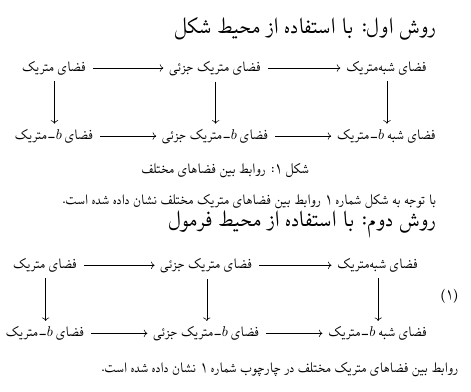با درود
۱. من دیاگرام شما را به کمک بسته tikz-cd تهیه کردم که به نظر میرسد از محیط array برای این کار مناسب تر است.
۲. برای ارجاع نیز از دو روش استفاده شده است.
- استفاده از محیط شکل
- استفاده از محیط فرمول
\documentclass[11pt,a4paper]{report}
\usepackage{amsmath,amssymb,amsthm}
\usepackage{tikz-cd}
\usepackage[extrafootnotefeatures]{xepersian}
\settextfont[Scale=1]{Yas}
\setdigitfont[Scale=1]{Yas}
\begin{document}
{\LARGE روش اول: با استفاده از محیط شکل}
\begin{figure}[h]
\centering
\begin{tikzcd}[row sep=3em, column sep=4em]
\text{فضای متریک} \arrow[r] \arrow[d] &
\text{فضای متریک جزئی} \arrow[r] \arrow[d] &
\text{فضای شبهمتریک} \arrow[d] \\
\text{فضای $b$-متریک} \arrow[r] &
\text{فضای $b$-متریک جزئی} \arrow[r] &
\text{فضای شبه $b$-متریک}
\end{tikzcd}
\caption{روابط بین فضاهای مختلف}
\label{fig:metric}
\end{figure}
با توجه به شکل شماره \ref{fig:metric} روابط بین فضاهای متریک مختلف نشان داده شده است.
{\LARGE روش دوم: با استفاده از محیط فرمول}
\begin{equation}\label{equ:metric}
\begin{tikzcd}[row sep=3em, column sep=4em]
\text{فضای متریک} \arrow[r] \arrow[d] &
\text{فضای متریک جزئی} \arrow[r] \arrow[d] &
\text{فضای شبهمتریک} \arrow[d] \\
\text{فضای $b$-متریک} \arrow[r] &
\text{فضای $b$-متریک جزئی} \arrow[r] &
\text{فضای شبه $b$-متریک}
\end{tikzcd}
\end{equation}
روابط بین فضاهای متریک مختلف در چارچوب شماره \ref{equ:metric} نشان داده شده است.
\end{document}
